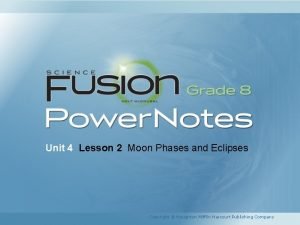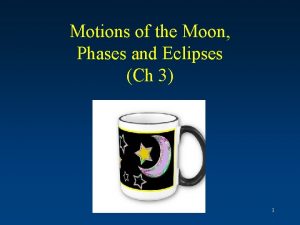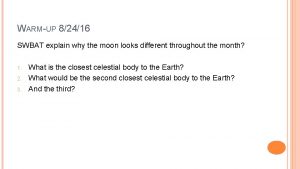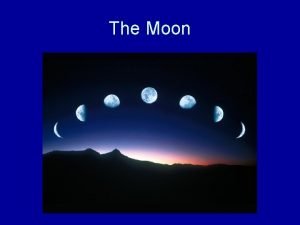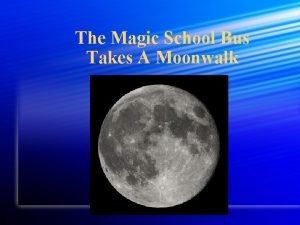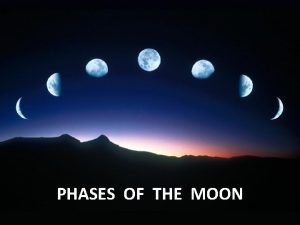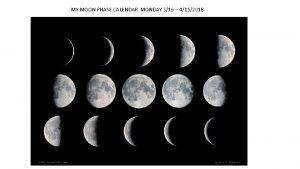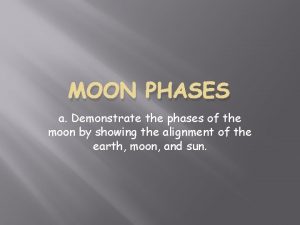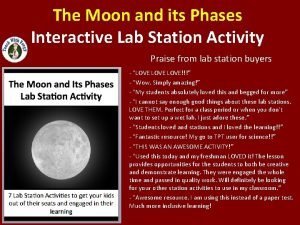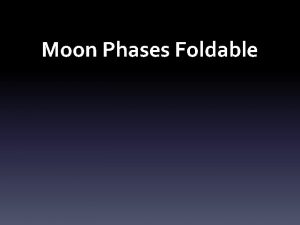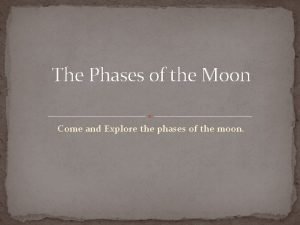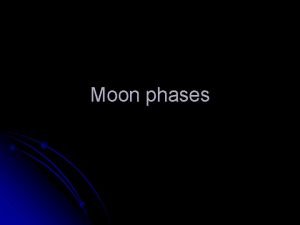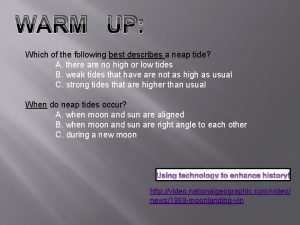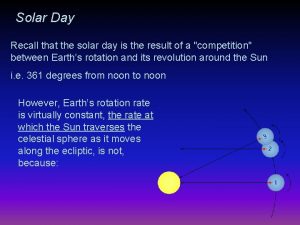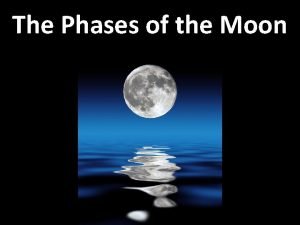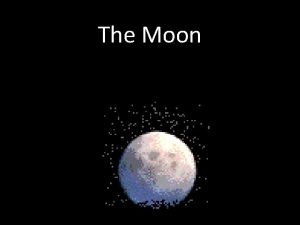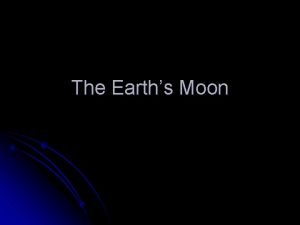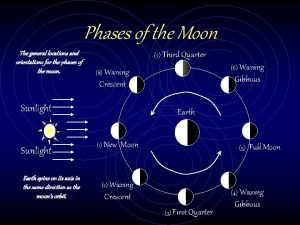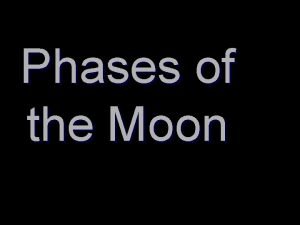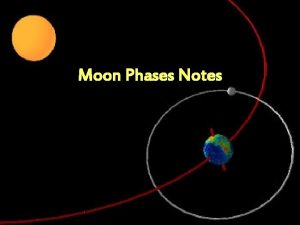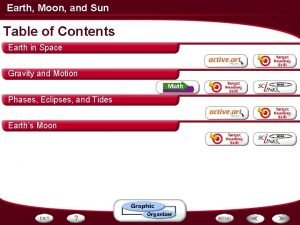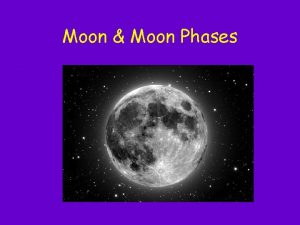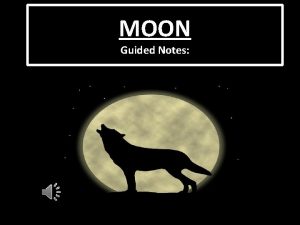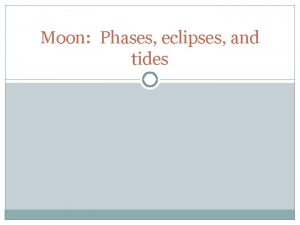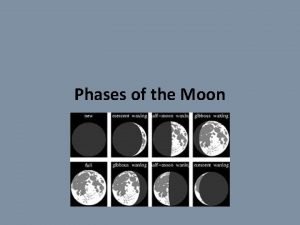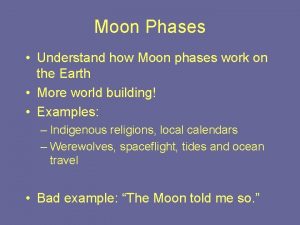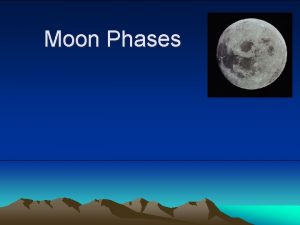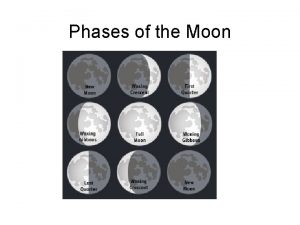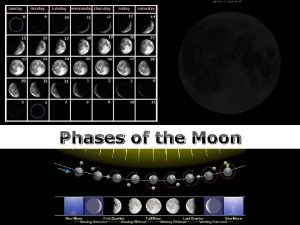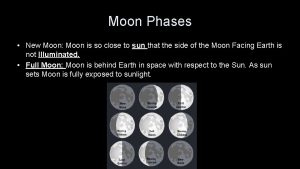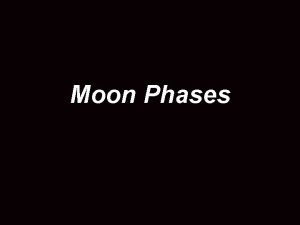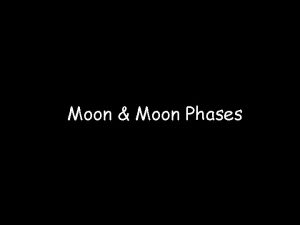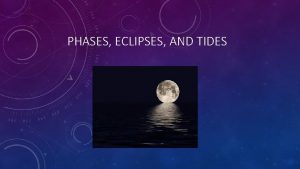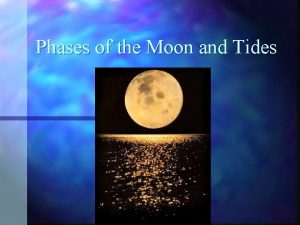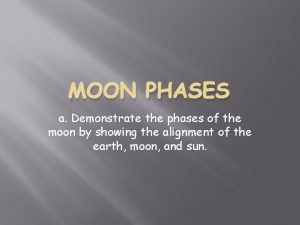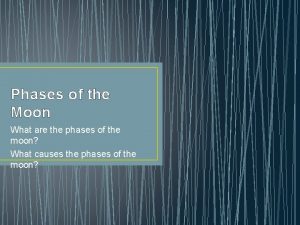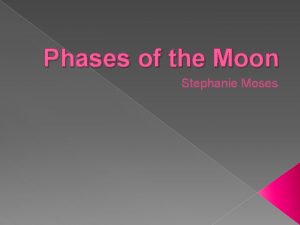Phases of the Moon The general locations and





























- Slides: 29

Phases of the Moon The general locations and orientations for the phases of the moon. (7) Third Quarter (6) Waning (8) Waning Gibbous Crescent Sunlight Earth spins on its axis in the same direction as the moon’s orbit. Earth (1) New Moon (5) (2) Waxing Full Moon (4) Waxing Crescent (3) First Quarter Gibbous

Perspective & The Moon’s Face How much of the moon’s face does the person see? Sunligh t NEW MOON Wherever the person looks all they see is shadowed moon. Earth (1) New Moon What time of day is it for the observer? Noon!!

Perspective & The Moon’s Face How much of the moon’s face does the person see? Sunligh t WAXING CRESCENT When you look up you see only a small crescent brightly lit. (Right Side) Earth (2) Waxing Crescent What time of day is it for the observer? 3 PM!!

Perspective & The Moon’s Face How much of the moon’s face does the person see? Sunligh t Earth Sunligh t FIRST QUARTER When you look up you see one half of the front face of the Moon brightly lit. (Right side) (3) First Quarter What time of day is it for the observer? Sunset - 6 PM!!

Perspective & The Moon’s Face How much of the moon’s face does the person see? Sunligh t Earth Sunligh t WAXING GIBBOUS When you look up you see only a small crescent, darkly shadowed, on the left. (4) Waxing Gibbous What time of day is it for the observer? 9 PM!!

Perspective & The Moon’s Face How much of the moon’s face does the person see? Sunligh t Earth (5) Full Moon Sunligh t FULL MOON When you look up you see the entire face of the Moon brightly lit. What time of day is it for the observer? Midnight-12 AM!!

Perspective & The Moon’s Face How much of the moon’s face does the person see? Sunligh t (6) Waning Gibbous Earth Sunligh t WANING GIBBOUS When you look up you see only a small crescent, darkly shadowed, on the right. What time of day is it for the observer? 3 AM!!

Perspective & The Moon’s Face (7) Third Quarter How much of the moon’s face does the person see? Sunligh t THIRD QUARTER When you look up you see one half of the front face of the Moon brightly lit. (Left side) Earth What time of day is it for the observer? Sunrise - 6 AM!!

Perspective & The Moon’s Face How much of the moon’s face does the person see? (8) Waning Crescent Sunligh t WANING CRESCENT When you look up you see only a small crescent brightly lit. (Left Side) Earth What time of day is it for the observer? 9 AM!!







What phase is the moon? What time of day will this moon phase be high in the sky? (meridan) What time will this moon phase set? What time will this moon rise?

What phase is the moon? What time of day will this moon phase be high in the sky? (meridan) What time will this moon phase set? What time will this moon rise?



This vintage 60 -kopek stamp celebrates a dramatic achievement. On the 7 th of October, 1959, the Soviet "Luna 3" successfully photographed the far side of the moon giving denizens of planet Earth their first ever view of this hidden hemisphere. Lacking the digital image technology familiar now, Luna 3 took the pictures on 35 mm film which was automatically developed on board. The pictures were then scanned and the signal transmitted to Earth days later in what was perhaps also the first interplanetary fax. In all, seventeen pictures were received providing enough coverage and resolution to construct a far side map and identify a few major features. Depicted on the stamp are regions dubbed the Sea of Moscow, the Soviet Mountains, the Bay of Astronauts, and the Sea of Dreams.



Have you ever seen a halo around the Moon? This fairly common sight occurs when high thin clouds containing millions of tiny ice crystals cover much of the sky. Each ice crystal acts like a miniature lens. Because most of the crystals have a similar elongated hexagonal shape, light entering one crystal face and exiting through the opposing face refracts 22 degrees, which corresponds to the radius of the Moon Halo. A similar Sun Halo may be visible during the day. The picture was taken in Lansdowne, Pennsylvania, USA. Exactly how ice-crystals form in clouds remains under investigation.





Waxing Phases Phase Rise Max. Height Set New Moon 6 am 12 pm 6 pm Waxing Crescent 9 am 3 pm 9 pm 1 st Quarter 12 pm 6 pm 12 am Waxing Gibbous 3 pm 9 pm 3 am Full Moon 6 pm 12 am 6 am

Waxing Phases Phase Rise Max. Height Set Full Moon 6 pm 12 am 6 am Wanning Gibbous 9 pm 3 am 9 am 3 rd Quarter 6 am 12 pm Wanning Crescent 3 am 9 am 3 pm New Moon 12 pm 6 pm 12 am 6 am
 Lesson 2 moon phases and eclipses answer key
Lesson 2 moon phases and eclipses answer key Moon phases and eclipses
Moon phases and eclipses Lunar eclipse moon phase
Lunar eclipse moon phase Moon phases of the sun is on the right
Moon phases of the sun is on the right During which phase of the moon do neap tides occur?
During which phase of the moon do neap tides occur? Magic school bus moon
Magic school bus moon What is the moon phase tonight
What is the moon phase tonight Hawaiian moon phases
Hawaiian moon phases What causes a crescent moon
What causes a crescent moon What causes the phases of the moon
What causes the phases of the moon Moon phases when the sun is on the left
Moon phases when the sun is on the left Moon phases interactive notebook
Moon phases interactive notebook Moon phases foldable
Moon phases foldable Moon phases foldable
Moon phases foldable Seven phases of the moon
Seven phases of the moon All phases of the moon
All phases of the moon Which earth
Which earth Which of the following best describes temperature brainpop
Which of the following best describes temperature brainpop Moon phases
Moon phases Phases of the moon animation
Phases of the moon animation Moon phases bingo
Moon phases bingo A waxing gibbous phase is ______.
A waxing gibbous phase is ______. What is the moon made out of
What is the moon made out of Moon phases characteristics
Moon phases characteristics Moon phases
Moon phases What phase is this
What phase is this How is the moon illuminated
How is the moon illuminated Phases of the moon notes
Phases of the moon notes What does a crescent moon mean
What does a crescent moon mean The phases of moon occur mainly due to
The phases of moon occur mainly due to
